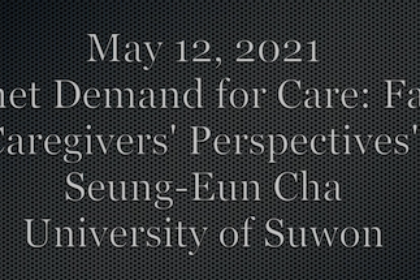
Korea faces a care conundrum where the proportion of family care provision for children and the elderly has been consistently large even though the supply of paid care workers has increased over the years. During the first day of the Concluding Annual Meeting, Dr. Seung-Eun Cha, (University of Suwon) presented collaborative research with Eunhye Kang (Seoul National University), Dr. Maria Floro (American University), Shirin Arslan (American University), and Arnob Alam (American University), that questions whether there is an unmet demand for care in South Korea. It also questions whether such an unmet demand results from a preference for family care or because primary household caregivers are unable to utilize outside care resources despite wanting to do so.
The study contrasts the current number of hours primary household caregivers (usually, women – specifically daughters-in-law), spend on care activities with their preferred number of hours they would like to spend on care activities; the premise being that if there is a gap between the actual time and the preferred time, then, there must be an unmet demand for care services.
The study uses data from the 2018 Care Work-Family Survey on Childcare and Eldercare in South Korea and studies a sample of 1001 households. Results show that, on average, primary household caregivers spend about 26 and 20 hours more than they prefer each week on eldercare and childcare, respectively. Primary caregivers also reported the number of hours they would prefer their spouse to provide care. Results show that they prefer the spouse to engage in more care work, even if they are currently utilizing paid care services; specifically, around 3 and 7 hours more than they do currently on eldercare and childcare. Low-income groups have a relatively larger unmet demand for eldercare and childcare, while more educated mothers experience a more significant gap for childcare. Furthermore, households in rural areas also showed a larger unmet demand for childcare.
To watch the full presentation, see below.
Written by Praveena Bandara, Research Assistant for the Care Economy Project and PhD student in Economics at American University.
